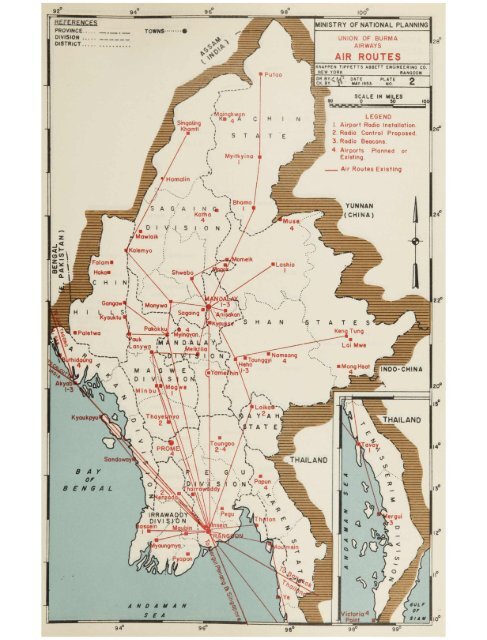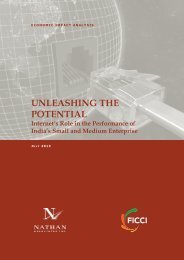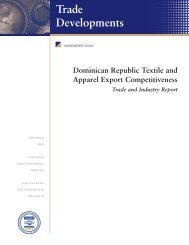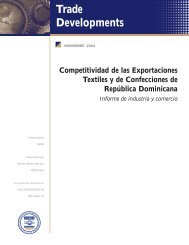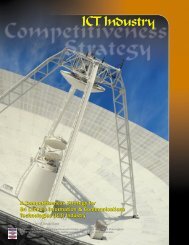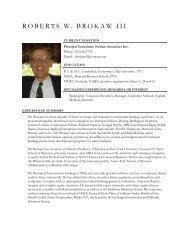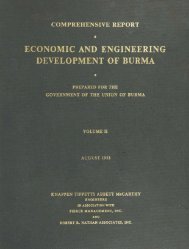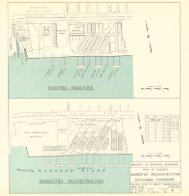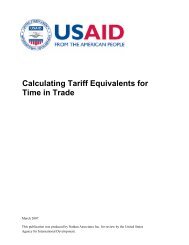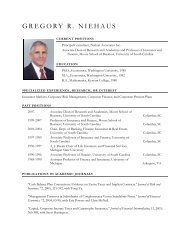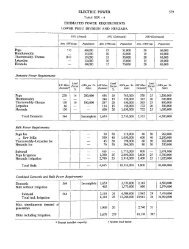Burma Development 1953 Vol1 Part12.pdf - Nathan Associates
Burma Development 1953 Vol1 Part12.pdf - Nathan Associates
Burma Development 1953 Vol1 Part12.pdf - Nathan Associates
Create successful ePaper yourself
Turn your PDF publications into a flip-book with our unique Google optimized e-Paper software.
92° 94^REFERENCESPROVINCE TOWNSDIVISIONDISTRICT
TABLE XVII-4UBA—FARES AND EXCESS BAGGAGE RATES(Intermediate Stations)EflFective July 1, 1952.FromjToExcess FreightSingle Return Baggage Rate(kyats) (kyats) per lb. per lb.(kyats) (kyats)Akyab-Kyaukpyu 22.00 41.80 0.20 0.20Bassein-Henzada 25.00 47.50 0.20 0.20Bassein-Myaungmya 13.50 25.65 0.20 0.20Bhamo-Mandalay 65.00 123.50 0.30 0.25Bhamo-Myitkina 26.00 49.40 0.20 0.20Bhamo-Putao 70.00 133.00 0.40 0.25Gangaw-Kyauktu 20.00 38.00 0.20 0.20Gangaw-Pakokku 35.00 66.50 0.20 0.20Gangaw-Pauk 30.00 57.00 0.20 0.20Gangaw-Lanywa 35.00 66.50 0.20 0.20Gangaw-Monywa 45.00 85.50 0.25 0.20Gangaw-Mandalay 65.00 123.50 0.30 0.25Heho-Loikaw 25.00 47.50 0.20 0.20Heho-Mandalay 35.00 66.50 0.20 0.20Heho-Keng Tung 60.00 144.00 0.30 0.25Heho-Lashio 70.00 133.00 0.40 0.30Heho-Toungoo 40.00 76.00 0.20 0.20Heho-Momeik 80.00 152.00 0.45 0.40Kalemyo-Mandalay 48.00 91.20 0.25 0.20Kalemyo-Monywa 35.00 66.50 0.20 0.20Keng Tung-Lotkaw 65.00 123.50 0.30 0.25Kyauktu-Pauk 12.50 23.75 0.20 0.20Kyauktu-Gangaw 20.00 38.00 0.20 0.20Kyauktu-Pakokku 30.00 57.00 0.20 0.20Kyauktu-Lanywa 19.00 36.10 0.20 0.20Katha-Rangoon 170.00 323.00 0.75 0.65Katha-Mandalay 55.00 104.50 0.30 0.25Katha-Meiktila 80.00 152.00 0.45 0.40Katha-Myitkyina 40.00 76.00 0.20 0.20Lanywa-Mandalay 40.00 76.00 0.20 0.20Lanywa-Meiktila 25.00 47.50 0.20 0.20Lanywa-Pakokku 20.00 38.00 0.20 0.2TLashio-Mandalay 40.00 76.00 0.20 0.20Loikaw-Mandalay 55.00 104.50 0.25 0.20Magwe-Mandalay 45.00 85.50 0.20 0.20Magwe-Meiktila 25.00 47.50 0.20 0.20Magwe-Lanywa 25.00 47.50 0.20 0.20Mandalay-Anisakan 15.00 28.50 0.20 0.20Mandalay-Meiktila 25.00 47.50 0.20 0.20Mandalay-Monywa 25.00 47.50 0.20 0.20Mandalay-Momeik 45.00 85.50 0.30 0.25Mandalay-Myitkyina 95.00 180.50 0.40 0.30Mandalay-Shwebo 19.00 36.10 0.20 0.20Mandalay-Pakokku 30.00 57.00 0.20 0.20Mandalay-Putao 125.00 237.50 0.50 0.45Mandalay-Toungoo 65.00 123.50 0.30 0.25Meiktila-Pakokku 25.00 47.50 0.20 0.20Meiktjla-Toungoo 45.00 85.50 0.20 0.20Meiktila-Myitkyina 120.00 228.00 0.50 0.45Mergui-Moulmein 93.00 176.70 0.40 0.30Mergui-Tavoy 40.00 76.00 0.20 0.20Momeik-Bhamo 35.00 66.50 0.20 0.20Momeik-Myitkyina 55.00 104.50 0.30 0.25Monywa-Meiktila 30.00 57.00 0.20 0.20Moulmein-Tavoy 55.00 104.50 0.25 0.20Moulmein-Thaton 15.00 28.50 0.20 0.20Myitkyina-Putao 40.00 76.00 0.20 0.20Pakokku-Pauk 25.00 47.50 0.20 0.20Pauk-Lanywa 25.00 47.50 0.20 0.20Pakokku-Monywa 25.00 47.50 0.20 0.20AIRWAYS 471TABLE XVII - 5FLIGHT DATA FOR BORDER AND NORTHERNSTATESDistrict or StateSouthern Shan StatesEastern Shan StatesNorthern Shan StatesMyitkyinaNaga HiUsUpper ChindwmKathaSpecial Division of theChm HillsArea(sq. mi.)25,00019,90016,20029,7009.50010.6005,70010,000AirportHehoKeng TungLashio and MomeikPutao and MyitkyinaSingaling KhamtiKalemyoKathaNone* Fortnightly.FlightsWeeklyTable XVII-1, showing the potential support value ofthe various districts, and Plate 1-2, showing the dis¬trict locations, together indicate which of the presentairfields most need increases in service.(b) An airstrip should be constructed at Homalin,approximately halfway between Singahng Khamtiand Kalemyo, to serve the valley of the Chindwin.(c) Immediately upon securing the area, the Papunairstrip should be developed and flights scheduled.(d) A survey should be made of the special divisionof the Chin HiUs to determine the most advantageouslocation for an airstrip from the viewpoints of popu¬lation and business. Immediate programming of theconstruction should follow this survey.D. PERSONNELThe personnel organization of the various depart¬ments is presented in Tables XVII-6 through XVII-10.1. OBSERVATIONS(a) Less than 5% of the entire organization is nonnational,this group consisting of most of the pilotsand department heads of the Fhght Operations andMaintenance Departments.(b) Table XVII-6 (see next page) presents theorgaiuzation for UBA as originally presented in thePrehminary Report. No changes are recommended.(c) Table XVII-7 presents the organization for theOperations and Maintenance Departments of UBA.(1) The Operations Department presently has astaff of 42, headed by the Chief Pilot. There are 12pilots, 13 co-pilots, and 13 radio operators to operatethe fleet, which consists of eight Dakotas, three Doves,three Marathons, and two Consuls, 16 planes in all.It would appear that 25% of the fleet is grounded at alltimes.4112*100
TABLE XVII-6ORGANIZATION CHARTON OF BURMA AIRWAYS• i^ • I»•CHAIRMANGENERAL MANAGERMANAGER(TECHNICAL)MANAGER(COMMERCIAL)SUPERINTENDINGENGINEERCHIEFPILOTTRAFFICSUPERINTENDENTCHIEF TRAFFICOFFICEROPERATIONS AND MAINTENANCEBOOKING AND HANDLINGADMINISTRATIVEOFFICERCHIEFACCOUNTANTADMINISTRATIVEAND GENERALSTAFFACCOUNTINGSTAFF ETC.ADMINISTRATION AND ACCOUNTS472
TABLE XVII-7ORGANIZATION CHARTUNION OF BURMA AIRWAYSOPERATIONS & MAINTENANCE DEPARTMENTS1 ■/^m/—r ri inrn iM-m.. n-\r-ii. IT-1 x-rri^^c: otjrciMiN i CINL/CIN I | IPROPELLER ENGINEERGENERAL OFFICESUPERINTENDING ENGINEER'S OFFICEPROPELLER OVERHAULTOTALEMPLOYEESEXCLUDINGSUPERVISION14410GENERAL MANAGER SR. O/H ENGINEER ENGINE OVERHAUL19Total Staff = 423ELECTRICAL ENGINEERINSTRUMENT ENGINEERELECTRICALINSTRUMENT2117RADIO ENGINEERRADIO12OPERATIONSCHIEF PILOTPILOTS 121MAINTENANCE' SUPERINTENDING ENGINEER 1■**SR. LINE-MAINT. ENGR. 1 **ENGINEER3 **SR. SUPERVISOR3SUPERVISORS3JUNIOR SUPERVISORS3SR. ENGR. OVERHAULS 1SR. SUPERVISOR2SUPERVISOR4AIRCRAFT RECORDSLINE MAINTENANCERECEIPT & DISPATCHREFUELINGPOWER PLANTWHEEL & TIRE OVERHAULWORKSHOPSCOMPONENTS OVERHAULHYDRAULIC & PNEUMATICUNDERCARRIAGE OVERHAULAIRCRAFT OVERHAULAIRCRAFT FINISHING74CO-PILOTS 13' -FABRIC SHOPMETAL WORKSHOPRADIO OPERATORS 13 STORES SUPT. 1CLERKS & STENO'S 3AIRCRAFT STORESTOOL & EQUIPMENT STORESINFLAMMABLE MATERIAL STORESHARDWARE STORES14422Total 42SECURITY OFFICER 1SECURITY SECTIONHANGAR CLEANING CREW2210SANITARY CREW4HEAD CARPENTER 1 CARPENTRY5• Three 8-hour Shifts♦♦ Two 8-hour ShiftsTotal 312Total 346
PUots are paid a bonus for all flying over 60 hoursper month. At present, pilots are averaging 120 hoursor more each month. An excerpt from the Pacific-Alaska Operations Manual of Pan-American Airlines,covering basic fiight-time limitations for pilots andflight engineers is included for information. TheManual is based on CAA Regulations which shouldbe used as a standard for comparison with UBARegulations.EXTRACTS FROM PAA OPERATIONS MANUALFLIGHT-TIME LIMITATIONS FOR PILOTSAND FLIGHT ENGINEERS1. CAR 41.54 Aircraft having a Crew of One or Two PilotsA. A pilot may be scheduled to fly eight hours or lessduring any 24 consecutive hours without a rest periodduring such eight hours. If a pilot is scheduled to flyin excess of eight hours during any 24 consecutivehours, he shall be given an intervening rest period ator before the termination of eight scheduled hours offlight duty. Such rest period must equal at least twicethe number of hours flown since the last precedingrest period and in no case will such rest period be lessthan eight hours. During such rest period, the pilotmust be relieved of all duty with the air carrier.B. When a pilot has flown in excess of eight hours duringany 24 consecutive hours, he must receive at least 18hours of rest before being assigned any duty with theair carrier.C. A pilot shall not fly in excess of 32 hours during anyseven consecutive days. Relief from all duty for notless than 24 consecutive hours must be provided forand given to a pilot at least once during any sevenconsecutive days.D. A phot shall not fly as a member of the crew more than100 hours during any one month.E. A phot shah not fly as a member of the crew more than1,000 hours in any 12-month period.2. CAR 41.55 Aircraft having Two Pilots and One Ad¬ditional Flight Crew MemberA. A pilot may not be scheduled to fly a total of morethan 12 hours during any 24 consecutive hours.B. When a pUot has flown 20 hours or more during any48 consecutive hours, or 24 hours or more during any72 consecutive hours, he must receive at least 18 hoursof rest before being assigned to any duty with the aircarrier. In any case, each pilot shall be relieved fromall duty for not less than 24 consecutive hours duringany seven consecutive days.C. A pilot shall not fly as a member of the flight crewmore than 120 hours in any 30 consecutive days or 300hours in any 90 consecutive days.D. A pilot shall not fly as a member of the flight crewmore than 1,000 hours in any 12-month period.AIRWAYS 4733. CAR 41.56 Aircraft Having Three or More Pilots and anAdditional FUght Crew MemberA. Flight hours shall be scheduled in such a manner as toprovide for adequate rest periods on the ground whilethe pilot is away from his base. Adequate sleepingquarters on the aircraft must be provided in all caseswhere a pilot is scheduled to fly more than 12 hoursduring any 24 consecutive hours.B. A pilot, upon return to his base from any flight orseries of flights, shall receive a rest period of not lessthan twice the total number of hours flown since thelast rest period at his base and during such period wiUnot be required to perform any duty for the company.When the required rest period exceeds seven days, thatportion of the rest period in excess of seven days maybe given at any time before the pilot is again scheduledfor flight duty on any route.C. A phot shall not fly as a member of the flight crewmore than 350 hours in any 90 consecutive days.D. A pilot shall not fly as a member of the flight crewmore than 1,000 hours in any 12-month period.4. CAR 41.76 Flight-time Limitations—Flight EngineersWhen one flight engineer is required, flight-time hmita¬tions of 41.55 apply. When two or more flight engi¬neers are required, flight-time hmitations of 41.56apply.The UBA has a training program and recruitsnationals to meet its requirements for new pilots. Thestudents attend flying schools in England, transporta¬tion and pay being provided by UBA. Twelve studentshave returned and are serving their pilots' apprentice¬ship (2,500 hours) as co-pUots.Consideration is being given by the UBA to sendinganother 12 students to UK for pilot training, as noneare now in training. The training period of three yearsis to be reduced to one year as the students taking the3-year training course received only one hundred andfifty flying hours. The Ministry of Education selectsthe trainees by rigid methods and all students whowere previously sent for training completed thecourse. The training of radio operators is discussed inparagraph G-3-e of this chapter.Bad feeling exists because of the differences in wagesof the nationals and non-nationals who have servicecontracts. In consideration of the fact that pilots, copUotsand radio operators' prospective years of ser¬vice are hmited by the natural and unavoidablechanges in the tension to which they are subject, ahigher premium should be placed on their services. Aretirement program should also be developed.(2) The Maintenance Department presently has astaff of 378, headed by the Superintending Engineer. Inthis department, training is given as a routine matteralong with work performed. When the apprentice hasacquired skill, he is upgraded and given a license.
474 ECONOMIC AND ENGINEERING DEVELOPMENT OF BURMA<strong>Burma</strong> having orginally no trained aircraft mainten¬ance mechanics and supervisors, UBA was forced torecruit non-nationals on service contracts. These menwill be replaced as trained nationals acquire the neces¬sary experience and skiU. The Maintenance Depart¬ment not only handles maintenance of the aircraft,but also maintains the buses, trucks, suburbans andcars of the Transportation Department together withits own flight crew, hangar and automotive vehicles.The four new Bedford coaches are maintained andserviced by an outside contractor, but this is ex¬tremely expensive and it should be stopped.It is estimated that approximately a 20 % increasein total staff is required to return the planes andother vehicles to service promptly. Any increasein the number of planes and vehicles will require afurther proportionate increase in maintenance person¬nel.(d) The Traffic and Transportation Department andAccounting and Statistical Department are staffed en¬tirely with nationals (see Tables XVII-8 and XVII-9).The Traffic Department has further curtaUed itsoperations by contracting the booking and freighthandhng at 26 terminal airports and at four foreignairports to agents at an average rate of 7% of the pas¬senger and freight bookings out of these airports. Atthe domestic airports of <strong>Burma</strong> it has been noted thatinexperienced labor is used by the agents in unloadingand loading freight and frequently the pilot andTABLE XVII - 8stewards of the aircraft are forced to assist this in¬experienced labor. While on the ground, the flyingcrew would ordinarily expect to be relieved of anyduties and should be free to walk about and relax.These conditions should be corrected.(e) Table XVII-10 shows the organization for theOffice of the Director of Civil Aviation. As indicated,the positions of senior Flying Control Officer andSupervising Engineer are vacant, the Deputy Directorpresently performing the duties of these offices. Theofficers under the Deputy Director do not haveassistants qualified to understudy them. For example,the Chief Aerodrome Officer, in addition to his otherduties, is responsible for the implementation of theairport development program, described in paragraphI of this chapter. It is beyond the capabihties of oneman unassisted to supervise construction at over 30airports that will cost as much as 800 lakhs of kyatsover a four-year period. The Office of the DCA has aprogram for expansion of its organization but isholding it in abeyance.Table XVII-10 does not include the AerodromeOfficers and radio crews at the airports. The Aero¬drome Officers are responsible for management andmaintenance at the airfields, but need instruction andassistance. On the inspection flight to Pauk onFebruary 20, <strong>1953</strong>, the pilot came in for a landingtwice, only to have to overfly cattle on the landingstrip. At Akyab the Aerodrome Officer employs twoUNION OF BURMA AIRWAYSTRAFFIC AND TRANSPORTATION DEPARTMENTManager—Commercial 1RangoonTransportation SectionChief Traffic Officer 1Movements Officer 1„ Assistants 4Upper Division Clerk 1Lower ,, ,, 1Drivers 43Cleaners 7Traffic Officer- -Agent 1 Traffic Officer- -Freight 1Traffic Officer OSD 1 In-freight2Traffic Officer- -Claims 1 Out-freight5Acceptances1Newspapers4Freight Shed2Traffic Officer—ExternalPassage BookingsFreight BookingsPassenger Handling1225Traffic Officer—ExternalHandling 1Booking Cashier 1External BaggageSales Girls 5Airport Cashiers 2Sales Statements 1Traffic Superintendent 1Airport Assistants 4Traffic Handling 5Traffic Handling 10Flight Duties 7Traffic Officer 1Sr. Traffic Assistant 1Jr- „ „ 1Traffic Clerk 1
TABLE XVII-9UNION OF BURMA AIRWAYSACCOUNTING AND STATISTICAL DEPARTMENTCHIEF ACCOUNTANTSENIOR ACCOUNTS OFFICERBillingSection1 SAC2 UDC2 LDCRevenueCollect¬ing Sect.2 UDC2 LDCAsst. Accts.Officer IAsst. Accts.Officer IIIAsst. Accts.Officer IICashSect.1 Cashier2 UDC2 LDCGenl.Sect.1 UDC2 LDCInt. AuditSectionI SAC3 UDC4 LDCInt. Agen.&BranchesI SAC3 UDC4 LDCExt. Agen.&Branches1 SAC2 UDC3 LDCMing. Asst. Accts.Officer IStatistical OfficerAccountant Cashier1Statistics1 SAC2 UDC2 LDCMaterialCosting1 SAC2 UDCI LDCWorksLedgers1 SAC2 UDCI LDCNote: SAC ^ Senior Accounts ClerkUDC -^ Upper Division ClerkLDC == Lower Division Clerk
TABLE XVII-10GOVERNMENT OF THE UNION OF BURMACIVIL AVIATION DEPARTMENTOFFICE OF THE DIRECTOR OF CIVIL AVIATIONDirectorofCivil AviationDeputy Director ofCivil AviationSenior FlyingControl OfficerVacantChiefTechnical OfficerChiefAerodrome OfficerChiefSignal OfficerSupervisingEngineerVacantATCSAR AIS AIRAIGADMINFINANCECOMMWORKSAGAI Branch ClerkI Upper DivisionClerk3 Lower DivisionClerksI Branch ClerkI Upper DivisionClerk4 Lower DivisionClerksI BranchClerk1 U.D.C.2 L.D.C.I Account¬ant1 U.D.C.2 L.D.C.I Branch Clerk1 Upper DivisionClerk2 Lower DivisionClerksI Branch Clerk1 Upper DivisionClerk2 Lower DivisionClerksLEGENDATC --= AIR TRAFFIC CONTROLSAR .. SEARCH & RESCUEAIS = AERONAUTICAL INFORMATION SERVICEAIR = AIRWORTHINESSAIG = ACCIDENT INVESTIGATIONADMIN = ADMINISTRATIONCOMM = COMMUNICATIONSAGA = AERODROME & GROUND AIDSPROPOSED REVISIONOFFICE OF SUPERVISING ENGR.Super. Engr. (Airports)Asst. Super. Engr. (Airports)Airport Design Engr.Structural Engr., Electrical Engr.Mechanical Engr.3 Engr. DraftsmenInspectors and Construction Engineersas requiredClerks — No change
laborers by the year to keep cattle off the paved run¬way and 30 laborers to cut the grass. A tractor-drawnmowing machine, which would amortize its initialcost in the first year of operation, could replace the30 men. A five-strand barbed-wire fence or a singlestrandelectrified fence could keep the cattle off thefield. The maintenance crew could be cut to threewhose duties would be to operate and maintain thetractor and keep the fence in repair.2. RECOMMENDATIONS(a) The number of pilots, co-pUots and radiooperators should be increased to 24. This wUl permitadequate rotation of the crew in the operation of thepresent fleet of 16 planes and reduce the probabihtyof accidents due to crew fatigue.(b) The pUot-training program should be placed ona continuing basis.(c) Foreign crew members should be replaced assoon as the training program permits.(d) A retirement program, financed by GUB,should be initiated at once for all UBA employees,particularly crew members.(e) The personnel of the Maintenance Departmentshould be augmented as recommended by the Super¬intending Engineer. The increase in personnel for thepresent work load should not be more than about 75employees (20%).(/) The agents who have contracted to handle book¬ing and freight should be required to use experiencedlabor in handUng freight.(g) In DCA, the positions of Senior Flying Officerand Supervising Engineer should be filled by quahfiedindividuals. The Supervising Engineer should be as¬sisted by an engineering section capable of preparingplans and specifications for and supervising the con¬struction and heavy maintenance of airfields.The Office of the Supervising Engineer should becharged with all construction and improvements toairfields and vsdth the preparation of estimates andreports. Five engineers and three engineering drafts¬men should be provided in addition to the SupervisingEngineer. One of the engineers should be from thecivU field, experienced primarUy in airfield pavements,airfield drainage and the application of soU mechanicsto airfield pavement design. One should be a structuralengineer famihar with airfield structures. Anothershould be an electrical engineer experienced in airfieldhghting, navigation aids and power supply for thevarious maintenance shops and mobile equipment atthe airfield. The fourth should be a mechanical engi¬neer experienced in all phases of air conditioning,heating and ventUating as apphed to airport construc¬tion. The Assistant Supervising Engineer should be acivU engineer, understudy to the Supervising Engineer.AIRWAYS 475All should be qualified for temporary assignment tothe field on supervision of construction.(It) The Aerodrome Officers employed at thevarious airports should be engineering graduates andshould receive training under both the Chief Aero¬drome Officer and the Supervising Engineer prior toappointment.E. AIR SAFETY, AIRCRAFT AND WORKSHOP1. AIR SAFETYa. Safety RecordUBA has a notable air safety record for the fourand one half years since its formation. It is estimatedthat in excess of 120 miUion passenger miles have beenflown, with a total of 11 fatahties, or 11 miUion pas¬senger miles per individual fatality.One Dove aircraft was lost to insurgents, one burnedoff its gas as it skidded on a collapsed landing gear. Inneither of these accidents were lives lost. One Dakotaaircraft, upon attempting to land at Mergui, wasdropped by a cool thermal, had a wing sheared by treetops in the approach zone, and spun in on the overshotzone outside the threshold of the airstrip. The pas¬sengers and crew left the plane safely before a slowfire burned out this aircraft. The cause of the loss ofthe de Havilland Dove aircraft XY-ABO on March 14,1949, could not be determined by the Board of Inquiry.This aircraft was seen from shore to fall and sink inthe Gulf of Martaban offshore from the mouth ofMyitkyina Creek. Nine passengers and two crewmenare presumed to have been drowned, and there wereno survivors. As no airport radio installation wasthen at Moulmein it was only the failure of the air¬craft to return to Rangoon which inspired search"efforts. The Board of Enquiry recommended "radiofacihties be instaUed at all stopping places for internalservice."b. Safe Operating ProceduresIn order that the record of safety be maintained, theUBA exercises vigilance in every phase of operations.The Superintending Engineer, the Chief Pilot, theChief Signals Officer, and the Duty Officer, whochanges daUy and is normally a co-pilot, all havecertain requirements prerequisite to a scheduled ornon-scheduled flight before any aircraft is givendeparture clearance.(1) Continuing Airwortliiness of AircraftCertificates for continuing airworthiness of aircraftare renewed periodically at intervals not exceeding 12months and cover a complete overhaul including: re¬moval of all components of the aircraft even to theentire removal of ah paint upon the airframe to check
476 ECONOMIC AND ENGINEERING DEVELOPMENT OF BURMAfor cracks or fissures; overhaul of propellers withappropriate tests; overhaul of the fuel system, testingfor flow rates, vapor lock, fuel-feed system arrange¬ment, tank strength, construction and instaUation,and checking fuel indicators, flowmeters, fittings,valves and accessories, and fuel-jettisoning systems;testing the oU systems, coohng power plant instru¬ments and controls, exhaust systems, induction sys¬tems, firewalls and cowhng, and fire protection. Alltests are made under the supervision of properlyqualified certificated mechanics.(2) Operations of AircraftConformance with recommendations of ICAO isgenerally attempted by UBA, which is a primaryreason for the continuing record of safety of the air¬line. Exact records are kept of all aircraft conditionsduring fiight, and the ffight plans are prepared toavoid conflict with advice of Air Traffic Control, theMeteorological Bureau, and Communication Service.Weight limitations are carefully followed as to crew,fuel, passengers, baggage and freight. The conditionsof the airstrips limiting weights are also watched forsafe landing-load. All aircraft in UBA are providedwith an operation manual, a maintenance manual, amaintenance release and a journey log-book. Noncomphance,however, was noted to the requirementthat before a pilot acts as pUot-in-command on a routehe has never flown he shall be certffied for the routeby a pUot who has previously proven his knowledgeof the route. The importance of adherence with thisrecommendation cannot be overstressed.2. AIRCRAFTa. ObservationsService is inadequate especially for the transporta¬tion of perishable freight. UBA is unable to acceptcharters at all times; to provide search at all times; orto spare planes from the hne for minor repairs ormajor overhaul. Necessity for minor repairs to planesgrounded elsewhere than at Mingaladon frequentlyfinds UBA without a plane in reserve to take theneeded mechanics and parts to the airport. Curtail¬ment of schedules and the consequent loss of revenuewould result should several of the Dakotas, the work¬horses of the fleet, be in the shops at the same time.To serve the numerous smaU airfields in the vicinhyof Mandalay which are substandard for Dakotas, ashuttle service based at Mandalay and equipped withthe hghter-weight Doves should be instituted.The service performance of the Dakotas has beenso excellent for so long it is difficult to recommendany change other than that more consideration begiven to the use of the hghter Doves on the numerousshort hauls and low income producing routes. Thelow fuel consumption of the Dove on short flights upto 45 minutes permits it to complete such a flight onan amount of fuel equivalent to that used by theDakota for taxiing and warm-up prior to departure.The comparison of operational aircraft given inTables XVII-l 1,12 and 13, illustrates these character-TABLE XVII - 11AIRCRAFT V/EIGHT ANALYSIS1. Structure weight2. Power plant and systems weight3. Operating equipment weight4. Passenger equipment weight5.6.7.8.Empty weightCockpit crewCabin crewFixed storesUnusable fuel9.10. Basic weight11. Maximum oi! capacity12. Equipped weight13. Maximum usable fuel capacity14. Corresponding payload15.16.17.18.19.20.21. Maximum landing weightUsable fuel with capacity payloadCapacity payloadDisposable loadGross weightPreflight fuel allowancesMaximum take-off weightTABLE XVII - 12Dove I Dakota HI{all weights in lbs.)2,3902,1608304405,820400506,2701306,5001,1609402,1002,1008,50078,5008,500BASIC PERFORMANCE DATA1. Total take-off power2. Meto-power3. Cruise power assumed(mean)4. Percent of meto-power5.6.7.10.11assumed for cruiseCruising height at startof flight regimeCruising height at end offlight regimeAssumed average cruisingfuel consumptionAssumed specific cruisingfuel consumptionCruising speed at take-offweightCruising speed at 85 %take-off weightCruising speed at 70 %take-off weight12. Cruising consumption at85 % take-off weight13. Air miles per gallon14. Theoretical still-air rangeat operating height (no15allowances)Estimated take-off dis¬tance to reach 50 ft. onfull power at max.take-off weightUnitse.p.h.e.p.h.e.p.h.per centft.ft.lb. hr.Ib./e.p.h. hr.m.p.h.m.p.h.m.p.h.lb./milesa.m.p.g.Dove I69057041471-58,0008,00019404691791831871066-64Stat, miles 1,0952,3708,8305,6202,3401,74018,53060020025017019,75043020,1804,7503,1207,8707,87028,0505028,00026,000Dakota III2,4002,1001,05072-58,0008,0004700-4481661741782-702-551,7603,540
478 ECONOMIC AND ENGINEERING DEVELOPMENT OF BURMAF, AIRPORTS, FACILITIES AND TERMINALSAir inspection was made during December 1952and February <strong>1953</strong> of 27 of the airports. TableXVII-14, indicates the actual conditions found. Onlyduring the dry season of the year can UBA operateaircraft to ah 33 airports, as only seven of the airportsare usable in aU-weather conditions. Plate 3 is asample inspection form for an airport, based on ICAOstandards, for the heaviest class of aircraft presentlyin use in <strong>Burma</strong>. No further comment upon the poorconditions of the actual airstrips is necessary than tostate that on ICAO standards most of <strong>Burma</strong>'s air¬fields would be condemned for commercial traffic. Adigest of ICAO recommendations is to be found atthe end of this chapter.Paragraph I, Future <strong>Development</strong>s, presents theprogram of the office of the DCA. This programplaces greater emphasis on extending the system thanon improvement of the various airports now served.The excellence of the safety record of UBA cannot beattributed to the character of the airports, but mustbe a reflection of the ability of the pilots, coupled withcareful maintenance. Some of the existing airportshave been programmed for improvement, but theprogram is phased over too long a period and doesnot include aU of the needed work at airstrips. Theconditions of the approach and departure zones, theuse of rocks to define the edge of the paved strips, thenarrowness of the paved and usable strips, the ob¬structions found in the latter, the orientation of cer¬tain of the strips, and the lack of transverse drainageall require expeditious correction. The sample in¬spection check sheet (Plate 3) together with the digestof ICAO recommendations should constUute theminimum in design.Few of the airports have terminal buildings andfacilities. However, the development program of theDCA includes these features at certain of the airports.The development program should encompass the en¬the system. As stated elsewhere, the traffic and trans¬portation division of UBA contracts these services toprivate individuals at most of the airports for a com¬mission of 7% of the passenger and freight bookingoriginating at these airports.The transportation fleet at Rangoon has in theprevious year acquired three new Bedford coaches,and has a sizable fleet of buses and freight trucks tohandle passenger and freight traffic between its centralbooking office on Strand Road and Mingaladon.Other than this, the transportation service betweenthe airports and town terminals of the rest of thesystem is of such poor quality as to be out of keepingwhh the services generaUy expected in connectionwith air travel. At certain of the inland airports andseaports a high-bodied truck offers the only means oftransportation, the floor being the only seating pro¬vided, and a stool the means of access. The passengerhandles his own baggage. Such a condition leaves un¬limited room for improvement at little cost. The townterminal building is a symbol and advertisement ofthe airways system. These also could be improved atlittle cost.Digest of Recommended and Standard Practices for Engi¬neering Design of Aerodromes—International Civil Avia¬tion Organization Annex 14—Adopted May 29, 1951:Eff'ective November 1, 1951.The above authority recommends that design of air¬strips shall be fitted to the character of the traffic expected.The Union of <strong>Burma</strong> Airways is presently using aircraftwith single wheel-loads of approximately 15,000 lbs., andconsequently the design required by the above authorityplaces the airstrip in the class Code number 6 and therelated Code letter F, which shows a required basic lengthminimum of 3,500 ft. and maximum of 4,200 ft.; whichlengths are for airstrips constructed at mean sea level,temperature 59° P., pressure 29-92126 inches (1013-25millibars) of mercury.The recommendations for an increase in length fromthe minimum are as follows and are based on standardAmerican practices.Altitude Correction—Basic length to be increased by 7%of elevation above mean sea level.Temperature Correction—Altitude corrected length tobe further increased by 0-50% for each degree Fahrenheitwhich the temperature of the hottest month exceeds thestandard temperature of the site.Longitudinal Slope—The runway length be further in¬creased to correct for runway gradient at the rate of 20%of the length corrected for density altitude for each 1 % ofeffective runway gradient. The effective runway gradientis determined by dividing the maximum difference in run¬way center-line elevation by the total length of the run¬way.Runway Alignment—The number of runways at an aero¬drome and their orientation should be such that for aslarge a percentage of time as practicable but for not lessthan 95% there is at least one runway for which the sur¬face wind velocity component at right angles to its longi¬tudinal axis will not prevent the landing or taking off ofaircraft that the aerodrome is intended to serve. The com¬petent authority on design may, however, after takinginto consideration the fact that aircraft designs are be¬coming less critical with respect to wind conditions, decidethat the aerodrome is intended to serve those classes ofaircraft that are capable of being operated under moder¬ately high cross-wind conditions.Longitudinal Slopes—It is further recommended thatfor code F airstrips the slope of a straight hne joining thecenter points of the extremities of a runway should notexceed 1 % and along no portion of the runway should theslope exceed 1 -5 %. Where slope changes cannot be avoidedthe transition from one slope to another should be ac-
UOlDlfXQHiOHclSNI XONKo.wx >H2^>H;5:^ zzzzz >.>->«>^z ?->->HZ>- zzzzz zzzzllUlDlj^SujioSuis >■ >-?;z; zzzzz >-z>^zz zzzzz zzzzz zzzzoqsMtfsaaioadSNi XOM/(vMopuvs >- >^zz zzzzz >^z>^zz z>^zzz zzzzz z>-zzovmjaaJOHdSMI lOM}jnvj >^ >-zz ZZZJHZ >H>.>H>HZ >->-zzz zzzzz zzzzn:>t>lo^vj >^ >-2;z zzzzz >->^zzz >H>HZZZ zzzzz zzzzvuii(:>ftiXp\^ ?H>H>^Z>- 2>>.>.>H ^>'>^ZZ >->H>HZ>H z>>-zz zz>^>^maujinop^ zz>^>^z z* z>-z >->^zzz >^>';>z^ z>->^zz zz;^zVMi(u0J^ >>->-z;z zzzzz >^>-zzz >^>^zzz zzzzz zzzz:>f!3utop\[aaioHdSNi XOMuopv]DSuip\[ >-Z>'>^>- >.>,>,>.>, >.>.>H>.>H>^>->^>-z >'>^>-Z>^ >-z>^>^inS.i3pi >HZ>-ZZ z>^z>^z zzzzz Z>->H>^>-< z>^zzz zz>^zt>lUWPi >^>.>.z>^ zzz>^z >^>,>,>,z >->^zzz zzzzz zzzzviiuSunViip^i >^z>^zz zzz>^z >->H>^>^Z >H>^ZZZ zzzzz zzzzi(Divpuvp\[ >. JH>^Z>H >->^>W^>H>. >H>H>H>H>H z>-zzz zz>BMSVJ^ >H>H>HZZ zzz>-z >H>.>H>HZ ?">->-Z>^ Z>H>^ZZ zzz>^SMD:^IOJ >^>->-zz zzz>^z >^>->^z >H>'ZZZ zzzzz zz>^zOOllfSV-JP-,>->'>-ZZ Z>^>->'Z zzzzz z>^>^z>- z^^zz zz>^>-VMiCutrj )M>Z>- z>zzzPi>.>.>.z> Z>HZZZ zzzzz ZZ>'>ni^nviC^> >-zz z* zzz >^Z>'ZZ z>^zzz zzzzz zzzzni(dyinD((x >'Z>-ZZ ZZ5H>^Z 5H>.Z>^Z >^>^zzz zz>^zz zz>^z■>*1iSunx Su3)f >■ >-zz 2* zzz >^>^zzz z>-zzz zzzzz ZZ>HZoiiuaivx >.z>-zz zzzzz >H>HZ Z>"ZZZ z>^zzz ZZ>HZAHVpVZU3ffXa>iHH NOiiDfTaiSNOD "aHaNn si ai^o^ao-aav MHN V1—101f3H )^>^>Z.> z>-z>^z >H JM>^>,Z >»*» Z>->'ZZ ZZ>->HAWSUVQ > >%%Szzz>^z >^Z>'>'Z >^zzz zzzzz zzzzH ouiDi/g2>-z>^zz Z>^Z>HZ >^>^>->^z »>*%x zzzzz zz>^zmsssvg >.z^zz zzzzz >->«zzz Z>H>^ Z>H>'ZZ zzzzuo>ivsmy >-Z>'ZZ ZZZZ>H >^zzzz z>^zzz zzzzz zz>^zqvi(yfy >-Z>'Z2S zz>^>^z >^>^z>-^z >H>^>,>H5H Z>HZZZ ZZJHZft•I 'I .260c'.5Smo'oMO.go0.EoLH•oo0 n>T 3 a"^d-as.S .Si^..3 "QSS.^) ^^O'' ^-^-- . . ', 7.!W
CLASS F AIRPORTSSINGLE-WHEEL-LOAD OF 15,000 LBS.PAVEMENT DESIGNED FOR STATIC LOADING OF70 LBS. PER SQUARE INCHMAXIMUM TRANSVERSE SLOPE 1.5%II LONGITUDINAL '■ I, 5%ON THE PAVED RUNWAY AND 2%ON THE USABLE WIDTH BEYONDBASIC LENGTH TO BE INCREASED 7%OF THE ALTITUDE ABOVE MEAN-SEA-LEVELTHIS NEW LENGTH TO BE CORRECTED ADDING0.5% FOR EACH DEGREE FAHRENHEIT BETWEENTHE HOTTEST MONTH AND THE STANDARDTEMPERATURE OF THE SITE.THE ORIENTATION TO BE SUCH THAT 95% OFTHE TIME THE STRIP SHALL BE USABLEDESPITE SURFACE WIND VELOCITY.NOTE: SEE PRINTED INSTRUCTIONS FOROTHER DETAILS AND FACILITIES.LIST IMPORTANT RECOMMENDATION ON THEREVERSE SIDE OF THIS REPORT SHEET.LENGTHPAVED WIDTHUSABLE WIDTHGRADESDRAINAGETERMINAL BLOG.RADIO CONTROLEMERGENCY POWEREMERGENCY LIGHTINGSTAFF QUARTERSORIENTATIONSIGHT DISTANCERUNWAY STRENGTHSTRIP MARKINGSOVER-SHOTSTRANSVERSE SLOPESAPPROACH ZONESWIND SOCKSURFACE TREATMENTEXISTINGREQUIREDUNOBSTRUCTED APPROACH ZONES BOTH ENDSVERT.TO HORIZ. 1:30INSPECTION CHECK SHEETAIRPORT!2500'480MINISTRY OF NATIONAL PLANNINGINTERNATIONAL CIVIL AVIATIONORGANIZATION STANDARDS.I. NOVEMBER 1951.KNAPPEN TIPPETTS ABBETT ENGINEERING CO.NEW YORK RANGOONDR. BY. E.J.P. DATE PLATECK. BY.E.P.T MAY 53. NO.
AIRWAYS 481comphshed by a curved surface with a rate of change notexceeding 0-3% per 100 feet. This is equivalent to a mini¬mum radius of curvature of 33,000 feet.Sight Distances—^Where slope changes cannot beavoided, they should be such that there will be an un¬obstructed line of sight from any point 10 feet above therunway to all other points 10 feet above the runway withina distance of at least half the length of the runway.Distances Between Slope Changes—Frequent undula¬tions or appreciable changes in slope located closetogether along a runway should be avoided. The distancebetween two successive transition curves measured fromtheir points of intersection of the curve should be not lessthan the sum of the absolute numerical values of thecorresponding grade changes multiplied by 25,000 feet.Example: x the grade to the left, y the grade withinthe two points on intersection curves and z the grade tothe right are successively plus 0-01, minus 0-005, and plus0-005.And 25,000 times (x minus y, plus, y minus z).Therefore: x minus >» — 0-015 and y minus z = 0-01.Or 25,000 feet times (0-015 plus 0-01) equals 625.Runway Strength—For code F airstrips (15,000 lbs.single wheel load) an associated tire pressure shall beassumed at 70 lbs. per square inch. This is ten lbs.greater than the DC-3 in use by the Union of <strong>Burma</strong> Air¬ways.Overshot Strip—Shah extend 200 ft. beyond the pavedrunway and have the required width, for class code Fairports, of 250 ft. each side of the center Hne.Transverse Slopes—Shall be such as to drain the surfacebut should not exceed 1-5%.Width of Usable Strips—For runways other than in¬strument operated, the width should be 250 feet each sideof the center line for code letter F runways. It is not in¬tended that areas paralleling and outside the 500 ft. ofusable strip be prepared in any way for landings butrather that they be cleared of hazards to aircraft.Strength—Those portions of the usable strip immedi¬ately beyond the paved runway should be so prepared orconstructed as to minimize hazards arising from the dif¬ference in load-bearing capacity, to an aircraft runningoff the paved runway.Width of Paved Runway—For airstrips in the class codeletter F the width should be 100 ft. Two parallel run¬ways should be separated 500 ft. on their center lines.Taxiways—Taxiways should be so provided as to per¬mit the safe and expeditious handling of aerodrometraffic.Aprons—Aprons should be provided as and whennecessary for the reasons above stated.Aerodromes—Lighting of aerodromes and marking ofobstructions nearby should be provided as traffic de¬mands.Approach Zones—For airstrips in the class code letter Fshould be trapezoids with center hnes the extension of therunway center lines, 500 ft. wide at the airstrip and 2,500ft. wide at a distance of 10,000 ft. from the airstrip. Theunobstructed glide path shall have a vertical-horizontalratio of 1 : 30.R.B.—31Horizontal Approaches—Have their inner edges at13,000 ft. from the geometric center of the runway and areconnected to the approach zone by transition slopes ofverdcal-horizontal ratio of 1 : 7.Wind-direction Indicators—All aerodromes shall beequipped with at least one wind-sock so located as to bevisible to approaching aircraft and unaffected by nearbystructures. They should be not less than 12 ft. long and 3ft. in diameter at the supported end. The color should bediscernable at 1,000 ft. having regard for background.White or orange is preferable and but a single colorshould be used.Signaling Lamp—Shall be provided at all aerodromes.Emergency Lighting—Shall be provided at all aero¬dromes intended for use at night.Aerodrome Identification Signs—Shall be provided wherethere is insufficient other means of identification. Itshould be the name of the aerodrome and in letters tenfeet high.Aerodrome Beacons Shall be provided at all aero¬dromes intended for use at night. For land aerodromesthe color shall be green and for water aerodromes yellow.It shall have a peak intensity of 2,000 candle power andemit light at all angles in azimuth and up to at least 45°above the horizontal. They shaU be on or adjacent to theaerodrome and identification characters shall be trans¬mitted in the Morse Code at a speed of between six toeight words per minute, the corresponding range ofduration of the Morse dots being from 0-20 to 0-15seconds.Approach Day Marking System—When in the opinionof the competent authority the system is required; asingle row of markers at a minimum distance of 200 ft.and a maximum of 300 ft. apart shall be provided in themiddle of the runway at its approach end. They shouldhave a surface area of a minimum of ten square ft. andnot constitute obstructions.Threshold Markings Shall be provided at the end ofthe runway and shall number four across its width.Runway Designation Markings—All runways shall benumbered with a two-digit number at each end. Thenumber assigned shall be that whole number nearest toone tenth of the magnetic azimuth of the center-hne of therunway, measured clockwise from Magnetic North whenviewed from the direction of approach. Parallel runwaysshaU be so identified by "L" and "R" for two; by "L","C", "R", for three; and by "L", "LC", "RC", "R" forfour runways.Longitudinal Markings—Runway longitudinal markingsshould be displayed on all runways and should be one ofseveral recommended designs.Approach Lighting System—Shall be provided on allrunways intended for use at night and shall comply withone of several alternate recommended designs. Thisapplies also to runway threshold hghts.Emergency Power Supply—Shall be provided for radioand land-line communication equipment for aeronautical,mobile and fixed equipment and services and for mini¬mum lighting necessary to enable air-traffic servicespersonnel to carry out their duties.
482 ECONOMIC AND ENGINEERING DEVELOPMENT OF BURMAG. FLIGHT CONTROL AND SIGNALCOMMUNICATION1. FLIGHT CONTROLThere are three groups of frequencies in the v.h.f.band used for aircraft control. These are for Airfieldcontrol,Approach-control, and Area-control. The useof these frequencies is dependent on the density of theair traffic, for if only one aircraft was in the region itwould be possible to pass all instructions on one v.h.f.channel and to use the same frequency for D/F pur¬poses. Where a number of aircraft are flying in theregion of control, different frequencies are used. Thedivision of control is then dependent on the distanceof the aircraft from the controlhng airfield. Airfieldcontrol is the term apphed to the immediate vicinity.Approach control extends up to about 75 miles. AtMingaladon approach control applies within a radiusof 115 miles and area control to the boundary of theregion or the extreme range of the equipment. TheInternational CivU Aviation organization has as¬signed the Government of <strong>Burma</strong> at Rangoon aregion larger than <strong>Burma</strong> itself. This region is boundedby <strong>Burma</strong> land geographic boundaries and by the 92°and 100° meridian of east longitude to the 10° parallelof latitude north. Control of all aircraft is assumedupon their entry within this Region.The present density of internal air traffic requiresonly two frequencies at the minor airports; i.e. air¬field-control and approach-control.(a) Approach-control is utihzed for normal controland direction-finding facilities and its inside limit isthe airfield vicinity. This means that aircraft wUl be incontinuous contact on this frequency and that in theevent of distress a series of bearings will be availablefor assistance to the pilot.(b) Airfield-control is limited to the immediatevicinity of the airfield and is on a separate frequencyso that a minimum of interference is caused to anyaircraft requiring D/F assistance.(c) Radio beacons. Further navigational facilitiesfor domestic-flying aircraft are medium-powered MFbeacons placed at selected airfields in order that apilot may obtain fixes by means of the aircraft radiocompass. Thus within a grid of these beacons he canplot his absolute position. These are used also forhoming aircraft and facilitate landing at airstrips thatare in difficult locations to approach, as at Tavoywhere an adjacent mountain intrudes.In <strong>Burma</strong> there are five radio beacons, four ofwhich are on the coast at Akyab, Mingaladon, Tavoyand Mergui. One is at Mandalay. Because of themountainous terrain of much of <strong>Burma</strong>, because mostof the navigation is solely dependent upon visual aidduring periods of high cross-winds which can carrythe aircraft far off its course, and because visualnavigation during these periods is often prevented bypoor visibility, it is important that an internal grid ofradio beacons be installed so that the aircraft positioncan never be lost. If aircraft radio become inoperativefor reception, or if for some reason the aircraft cansignal only a distress landing without being able togive its position, the VHF/DF equipment can be usedto obtain azimuths of the distress signal and to furnishsearch and rescue information.It is noted that the office of the DCA has budgetedrequests for authorization to equip additional airportswhh radio. It is also noted that four years have elapsedsince an accident inquiry board recommended "allairports be radio equipped," and stUl two thirds of<strong>Burma</strong> Airways airports are without this facility.2. SIGNAL COMMUNICATION(a) Internal service R/T is for communications be¬tween aircraft and ground stations for the purpose ofpassing approved messages, such as estimated arrivaltime, position in case of distress, number of seatsavaUable and weight of freight which can be booked.This service can be used also to inform the trafficofficer at Mingaladon of any heavy traffic conditionso that a non-scheduled Uight can be arranged.(b) Radio controls and equipment are presently pro¬vided at but 12 of the 33 airports of <strong>Burma</strong> to whichservice is flown. The DCA has control of aU radioservices at airports so equipped. A nominal chargewas formerly made for each landing of aircraft at therate of KIO for Doves and K25 for Dakotas but hasbeen discontinued. Since January 1, 1952, the DCAhas taken over control of the full operations of Inter¬national Aeradio Ltd., with the exceptions of the maintransmitter station at Mingaladon and operations atMergui and Akyab. The main transmitter station atMingaladon is to be moved to another building as theBurmese Army requires the buUding for its use. Re¬pairs, adjustments and new instaUations of the UBAradio system are still contracted to InternationalAeradio Ltd. by DCA.3. CONCLUSIONS AND RECOMMENDATIONS(a) All airfields should be equipped with mediumpoweredMF beacons.(b) As is indicated in Table XVII-14, the DCA isfaced with the fact that 21 airfields to which UBA air¬craft are flown are without any radio control. Theinitial cost to equip each station is estimated atK52,000 for apparatus and K5,000 for instaUation.This would provide Aerodrome Control, InternalService R/T, VHF/DF, and Approach Control, andincludes the generators and petrol engines (one stand¬by). The cost of proper housing for apparatus, power,
and staff is set at a minimum of K20,000. From thiscan be seen that to fully equip 21 additional stationsthe total cost would be approximately K16-2 lakhs.The position is taken by some that, as many ofthese airfields have but one flight per week and severalonly two a month, it would be uneconomical to equipthem. The opposite position is taken by crew andpassengers alike when aircraft are unable to find suchairports as Keng Tung somewhere below the lowclouds and circled by 5,000 and 6,000-ft. peaks abovethe level and within ten miles of the airstrip. When theaircraft must return without making a landing, thedesirabihty of signal controls becomes quite apparent.It is recommended that the remaining 21 airfields beequipped with radio control and that any new airfieldsalso be so equipped.(c) In connection with the equipment requirementsof the 21 airports stiU without radio, it is noted that,in the past, the products of only one manufacturerhave been used for all planes and stations. It is pos¬sible that costs may be out of line as a consequence.This would also apply to emergency aircraft radiowith which aircraft, flying over such terrain as isgenerally found in <strong>Burma</strong>, should be equipped asrecommended by ICAO. It is recommended that theperformance data and costs for the equipment of com¬peting manufacturers be examined in order to obtainthe best equipment at the least cost.(d) It is recommended that the flight crew of allcommercial aircraft include a qualified licensed radiooperator.(e) The Preliminary Report recommended thatradio operators and maintenance technicians be giventraining in schools in <strong>Burma</strong> to be established byGUB. It is now considered advisable that the DCAestablish a radio operators' and technicians' school.This school would be available also to the RadioTelecommunications system, the entire GUB mihtaryestablishment, and the Shipping Board as well as toCivil Aviation. It can be seen that the broader needs ofall GUB indicate the continued need of such a school.The DCA is giving training to operators at presentbut the scope of this training is limited. A good radiooperator of any worth should know his equipmentwell enough to be able to instaU any part subject tofailure. This ability is not acquired from station train¬ing, nor are the station operators authorized andqualified by experience to make adjustments andrepairs. It is therefore recommended that GUBestabhsh a radio operators' and technicians' school toserve all agencies.H. ACCOUNTING AND STATISTICSThe financial statement of the UBA for the fiscalyear ending September 30, 1951, together with aR.B.—31*AIRWAYS 483profit and loss statement, are presented on TableXVII 15 (see next page). Comparable figures for theyears 1949 and 1950 are shown on the table. The netcash worth of UBA has improved each year. Thereis now no outstanding indebtedness, and the presentgross worth is entirely earned.Plates 4, 5 and 6 show Comparative Sources ofRevenue; Comparative Operating Expenses; andRevenue, Expenditure and Profit. From a study ofTable XVII-16, Monthly Traffic Records (see p. 488),and Plates 4, 5 and 6, the following can be deduced:1. Although passenger travel dropped 28% from1951 to 1952, the revenue dropped only 4%, duemainly to an increase in rates.2. For the years 1949 and 1950, A/C charter feesexceeded the income from passenger travel.3. Monthly Traffic Records indicate that passengertraffic has decreased with the decrease in servicesflown per month, but not in as great a proportion.This tabulation also shows a decrease in route milesper month but not in proportion to the decrease inflight services. This is also true of totals for baggagefreight and mail weights handled. The most importantconclusion is that the actual flight operations costshave been considerably reduced by better loadingsper aircraft and flight. However, the crowding of air¬craft with freight to the discomfort of passengers isnot consistent with the objectives of providing betterservices. Nearly a four-to-one heavier loading ofpassengers and a three-to-one heavier loading offreight occurred in 1952 than in the first six monthsof 1951.The accounting and statistical records for UBA,kept at the control terminal buUding on Strand Road,Rangoon, comply with GUB requirements and aresubject to interim and yearly audit of the Accountant-General's office. From the organization chart (TableXVII 9), the department appears to have sufficientpersonnel to perform its duties. However, the year-endreport is delayed too long before issuance. It is recom¬mended that a study be made of the Accounting,Fiscal and Statistical Department, to determine meansto increase its efficiency.I. FUTURE DEVELOPMENTSElsewhere in this chapter the foUowing majordevelopments have been mentioned as in progress orplanned:1. Operation of the airport radio by the DCA, asproposed by the Prehminary Report, has been takenover from International Aeradio Ltd.2. The training of phots in <strong>Burma</strong> has been deter¬mined uneconomical in comparison whh the cost inthe United Kingdom and it is planned to send anothertwelve students there.
00r-lo cs"osooCJ^-»9V-1OSoroBiWnbOVi
cnoCSM(SS soZ =0so5OSsoOCS oso «f- lo r- o?oCSt-- « OSOssoCSCS ^"^ 00■* cs__OS'I/T"O "Alcs'oTcnCScn OSCS ooen ^^■* CS O OS00 00 oo "o— ■* 00 Qm oo -^i- oCSo8OS -*m --CS CSo © Oo^ cn^ cnO C4 O Ctt£^ 8«C7 «. --i ca • O 'e i § i g00 cn w-i(S.-(QcoOO "O rnO'-iOtnoI 00to So D,! « SSw ?>< 6 cs ng >-- a P5« Di.fc>4 u^fS00B3 V}is^cn>?^ .3.0 taSiSP5 S-C3aom3 -- ''^■S o5 50 UJ3 V cy"Ml^o o8 oi:006o6CSOSm o■^ soH- 6 I I 1I--soo•* 00OS cn00 o(8 o Ren OSK 5 •»!- so3 3 3 00 CSSi6so o■*■*o6so6OS pCS o
1251949YEAR1950 1951 1952TOTALS. '57-7 252-7 130-3 ieo-4PASSENGERSFREIGHTEXCESS BAGGAGEMAILINCOME FROM CHARTER^MINISTRY OF NATIONAL PLANNINGUNION OF BURMA AIRWAYSCOMPARATIVESOURCES OF REVENUEKNAPPEN TIPPETTS ABBETT ENGINEERING CO.NEW YORK RANGOONDR. BY.^.^/0 DATE PLATECK. BY jfy^T^486MAY 53 NO.
YEARFLYING OPERATIONSGROUND OPERATIONSTRAFFIC HANDLING -A/C CHARTER FEES -TO GROSS PROFIT -TO NET PROFITMINISTRY OF NATIONAL PLANNINGUNION OF BURMAAIRWAYSCOMPARATIVEOPERATING EXPENSESKNAPPEN TIPPETTS ABBETT ENGINEERING CO.NEW YORK RANGOONDR. BY ^.J-./^ DATE PLATE (■CK BY J^/'TT MAt 53 NO. 0»487
488 ECONOMIC AND ENGINEERING DEVELOPMENT OF BURMATABLE XVII -16UNION OF BURMA AIRWAYSTRAFFIC RECORDSMONTHLY OPERATIONSBaggage Freight Mail TotalDate Flights Passengers (lbs.) (lbs.) (lbs.) Wt. (lbs.) MilesJanuary 1951 940 15,271 94,934 596,369 32,956 724,259 160,854February 1,023 15,721 102,285 807,787 31,410 941,482 175,270March 1,026 17,587 118,835 682,997 39,102 840,934 165,735April 1,136 19,319 117,015 724,974 32,176 874,165 179,628May 1,217 20,219 138,027 738,834 34,680 911,541 189,075June 1,041 13,550 124,460 609,315 33,325 767,100 155,851July 869 11,721 95,194 612,517 34,295 742,006 138,157August 725 12,614 92,173 636,904 43,034 772,111 111,755September 644 11,502 88,931 737,934 35,586 862,451 111,490October 229 11,114 79,097 527,631 22,743 629,471 129,499November 272 12,163 84,185 590,073 23,250 697,508 160,819December 262 11,347 74,415 561,031 26,168 661,614 134,937Total 9,384 172,128 1,209,551 7,826,366 388,725 9,424,642 1,813,070January 1952 250 10,482 66,031 542,107 23,994 632,132 118,180February 263 12,009 58,697 605,613 25,031 689,341 135,088March 265 12,837 63,207 537,081 23,100 623,388 146,081April 312 13,092 58,544 383,544 21,491 463,579 150,607May 267 12,078 70,658 444,309 22,798 537,765 142,929June 191 8,706 71,216 432,262 22,934 526,412 111,780July 238 9,132 52,995 463,295 24,820 541,110 126,655August 243 8,991 51,011 559,402 23,728 634,141 127,499September 225 7,935 52,293 434,533 21,448 508,274 84,648October 263 10,002 61,048 487,824 22,154 571,026 124,825November 255 7,820 59,397 524,351 23,984 607,732 135,020December 296 11,472 80,503 740,670 25,527 846,700 155,6093. Funding of the purchase of new aircraft is ap¬proved at the rate of K25 lakhs per year for the nextfour years.4. The enlargement of the maintenance shops atMingaladon is in progress, an additional main hangarhas been released by the BAF to UBA, and machinetools are being instahed.5. As proposed in the Preliminary Report UBA isnow starting maintenance service of BAF aircraft,having been assigned seven for fuh servicing.6. An increase in personnel of not less than 20% iscontemplated in the maintenance division.7. The office of the DCA has prepared, or caused tobe prepared, estimates for the program of airportdevelopment and improvement. The work at the air¬ports indicated below is to be included in the programfor <strong>1953</strong>-54 construction.WorkAkyab. The construction of an all-weather permanentrunway. The sanction of the Government to under¬take this work will be applied for on receipt of esti¬mates of costs from the PWD at Akyab.Victoria Point. The construction of an all-weather per¬manent runway. The sanction of the Government toundertake this work has been requested.Thayetmyo. The construction of an all-weather perma¬nent runway. The sanction of the Government toundertake this work has been requested.Mergui. The extension of runway. The PWD at Merguiis preparing a detailed estimate.Kyaukpyu. Improvements. TheEE (B & R) KyaukpyuDivision, reports that the estimate of this work will besubmitted after the Superintendent Engineer, Mari¬time Circle, has determined transverse gradients andpaving thickness.Tavoy. The construction of an all-weather macadamrunway. Sanction of the Government to undertakethis work has been requested.CostEstimate(kyats)10,00,00010,00,0005,60,0002,00,0007,50,0003,75,000
Myingyan. The construction of a new airstrip with workto start during <strong>1953</strong>-54. 4,20,000Bassein, Magwe and Heho. Resurfacing. Work at Hehoto be carried on during the current 1952-53 season,and Magwe and Bassein during <strong>1953</strong>-54. 9,00,000Momeik. Tar and stone screenings. Sanction of theGovernment to undertake this work has been re¬quested. 2,64,000Controlled Airfields. Barbed-wire fencing. Sanction ofthe Government has been requested. 2,00,000Controlled Airfields. Provision of labor staff quarters.Sanction of the Government has been requested. 1,17,000Toungoo, Henzada, Loikaw and Thayetmyo. Radio tele¬communications buildings. Sanction of the Govern¬ment has been requested. 80,000Sandoway (Mazin). Construction of permanent stafFandW/T building. Sanction of the Government has beenrequested. 30,000Total 58,96,0008. <strong>Development</strong> and improvements are in progressat the following eight airports.Carry-on WorkAkyab. A new modern terminal building. With construc¬tion completion to be by the end of 1954.Mandalay. A new modern terminal building. With con¬struction completion to be by the end of 1954.Buthidaung. A new civil aerodrome at this site. Sal¬vaged pierced-steel plank at Akyab has been takenover by the Pyidawtha Committee for this work. Thisairstrip is near the site of the proposed Saingdin FallsHydroelectric Project.Sandoway (Mazin). The construction of a permanentall-weather airstrip. Sanction of the Government hasbeen received. Completion is contemplated in 1954.Henzada. The construction of an entirely new airfieldhas been started against an allotment of K50,000 for<strong>1953</strong> with ultimate completion in 1954.Prome. The construction of a new airfield.Singaling Khamti. An aU-weather runway is underconstruction with Kl,00,000 authorized for <strong>1953</strong> andcompletion in 1954.Moulmein. A second seal coat has been started withcompletion estimated in 1954.The estimated total cost of this carry-on work isThe total costs for items 7 and 8 above is thesum ofAIRWAYS 489CostEstimate(kyats)3,00,0003,00,0003,00,0007,60,00016,00,00022,23,0005,04,00081,00060,68,0001,19,64,0009. Additional improvements. The above estimates onclose study disclose no re-orientation to windrosedirections, no extensive ffils or cuts to provide 500-ft.usable widths, and especially no clearing in the ap¬proach and departure zones for a distance of twomiles from the airstrip. They provide for no transversedrainage. The conditions of the airstrips to which theUBA are scheduling ffights are such that on ICAOrequirements 27 of the 33 would be condemned.The cost of the foregoing demandwork for the next 12 months isestimated atThe increase of 100 % in the UBA fleetTotal—Item 9Total—Items 7 and 8Total BudgetK30,00,000K60,00,000K90,00,000Kl,19,64,000K2,09,64,000J. CONCLUSIONS AND RECOMMENDATIONS1. PRELIMINARY REPORT RECOMMENDATIONSThe Preliminary Report reviewed the organization,plant and fachities, traffic ffight control, and the fiscalsituation of the UBA, and presented certain recom¬mendations. Subsequently, these recommendationswere considered by an advisory board on Civil Avia¬tion and Airways on behalf of the subcommittee onTransportation and Communications. This board wascomposed entirely of <strong>Burma</strong> Airways and civilaviation officials.Regulatory commission. The first recommendationof the Preliminary Report found under Section VIII,Transportation, urged the establishment of a regula¬tory commission to control the four major transportdivisions; i.e., railroads, highways, waterways and air¬ways. The advisory board of March 21, 1952, votedagainst such a regulatory commission. However, al¬though Airways rates are less directly competitivethan those of the other transportation systems, aproperly representative regulatory body would takeall such factors into account and would insure abalanced structure and proper safety practices for thecountry as a whole.Maintenance and training. The coordination andimprovement of the administrative functions of per¬sonnel training, workshop maintenance and a sparepartssupply for civil and mihtary aircraft was con¬sidered by the Advisory Board and action thereon isin progress. At present, UBA is maintaining sevenBAF aircraft and has obtained a second hangar badlyneeded to remove repairs from exposure to weather.The BAF, however, is reluctant to discontinue en¬tirely its own maintenance and is presentiy recruitingmechanics and training them. This may well beiustified for military reasons, and no further commentis offered.Operations training. The Preliminary Report recom¬mended training of pilots, radio operators and main¬tenance technicians in formal schools to be establishedin <strong>Burma</strong>. The advisory board rejected this on thepresumption that the need for phots is very hmited.However, it should be noted that pilots of mihtaryaircraft must receive an entirely different type trainingfrom that received by commercial pilots, the firstbeing taught risk-taking, the second being taughtrisk-avoidance. Radio operators are more easily ob¬tained, and maintenance technicians are soon shoptrained.Radio Operation. The Preliminary Report recom¬mended that the operation of the radio and signal net¬work be by the DCA. This is now the case and the ex¬pansion of the system is in progress, whh the instal¬lation of radio at Tavoy and Keng Tung now com-
2501949YEAR1950 1951252-71952200175-2> 1501577130-2t/iX** 100/118 8XF 120-4A64-9^76-196 850/24 IX31 023-7REVENUESEXPENDITURESPROFITS (NET)V. AMINISTRY OF NATIONAL PLANNINGUNION OF BURMAAIRWAYSREVENUE EXPENDITUREAND PROFITKNAPPEN TIPPETTS ABBETT ENGINEERING CO.NEW YORK RANGOONDR. BY S^/' DATE PLATE |*CK. BY^/^7" MAY 53 NO. "490
pleted, and of radio beacons at Tavoy, Keng Tung,Heho and Lashio in progress. Also an auxiharybeacon is to be located about 100 miles north ofRangoon on the Prome Road.Aircraft replacement. The Preliminary Report re¬commended the establishment of a fund for thephased replacement of aircraft. Steps have been takenby the UBA to set aside these funds and the sum ofK25 lakhs is annually to be allocated. The purchaseof three Marathon, Mark I aircraft late in 1952 wasnot, however, from these funds.2. COMPREHENSIVE REPORT RECOMMENDATIONSFor convenience, the various recommendationspresented in this chapter are summarized below. It isreconunended that:(a) An airlines agency be established to prepare thenecessary papers to clear air freight through customs.This service should be rendered free of charge.(b) The Rangoon Post Office close its air pouchesnot sooner than two hours before departure time.(c) Test ffights, advertised in advance, should bemade to the airports presently served to determinewhether an increase in traffic will result.(d) An airstrip should be constructed at Homahn,approxhnately half-way between Singaling KJhamtiand Kalemyo.(e) The Papun airstrip should be developed andflights scheduled immediately upon securing the area.(/) A survey should be made of the Special Divisionof the Chin Hills to determine the most advantageoussite for an airstrip.(g) The number of pilots, co-pilots and radiooperators should be increased to 24, and the numberof avadable crews kept at 150% of the number ofavailable planes.(h) The phot-training program should be made apermanent part of UBA.(0 Non-national crew members should be replacedas soon as the training program permits.(j) A retirement program, financed by GUB,should be initiated for all UBA employees, especiallycrew members.(k) The personnel of the Maintenance Division,UBA, should be increased up to 20% as recom¬mended by the Superintending Engineer.(/) The agents who have contracted to handlebooking and freight for UBA should be required touse experienced labor in handling freight.AIRWAYS 491(m) In DCA, the positions of senior Flying Officerand Supervising Engineer should be fihed by qualifiedindividuals. In addition, the Supervising Engineershould be provided with an engineering staff.(n) The aerodrome officers employed at the variousairports should be engineering graduates and receivetraining under the chief aerodrome officers and theSupervising Engineer.(o) Further study be made of the prospective pas¬senger-traffic loads and that the passenger fleet be in¬creased to accommodate these loads.(p) A shuttle service utilizing Dove aircraft shouldbe initiated between Mandalay and all airports lyingnorth of Lanywa and Heho.(q) Daily freight service utilizing C-47 aircraftshould be instituted between Rangoon and Mandalay,to be followed by a completely separated freight ser¬vice for the full system of airports.(r) An inventory of machine tools, hand tools andspare parts should be made, and the necessary toolsand spare parts purchased.(s) A program should be prepared and implementedto correct the deficiencies existing at the airfields, asindicated in Table XVII-14, and work should proceedimmediately.(t) Ah airfields, existing and proposed, should beequipped with complete radio control.(«) The performance data and costs for the radioequipment of competing manufacturers should beexamined in order to obtain the best equipment at theleast cost.(v) The ffight crews of all commercial aircraftshould include a qualihed licensed radio operator.(w) GUB should establish a radio operators' andtechnicians' school.(x) A study of the systems, supervision and relatedresponsibilities of the accounting department shouldbe made.(y) The system of airports should be enlarged tobetter serve the outlying districts. Ministers and otherofficials of these districts should be called upon toassist in locating the new airports.(z) DCA exercise more rigid supervision of thehandhng of traffic, both by UBA personnel andagents.(ad) A Safety Engineer, reporting only to theMinister of Transport and Communications, be em¬ployed to check on the strict compliance with thestandard safety recommendations of the ICAO.


